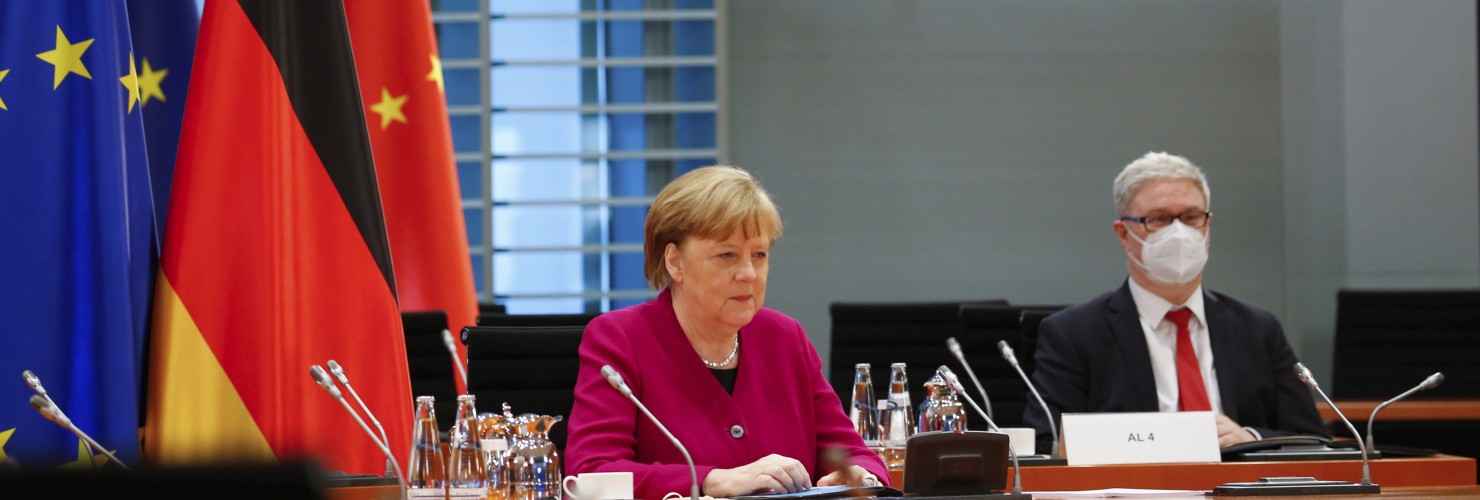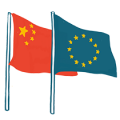

Sino-German government talks + Rural revitalization + Tesla
In what is likely to be her ‘last dance’ in China politics, Chancellor Angela Merkel led her cabinet into the sixth German-Chinese government consultations on Wednesday. Optimism and positivity surrounded its beginnings in 2011. Ten years later, relations are beset by uncertainty and tension.

The recent EU-imposed sanctions on China were met by an immediate, tougher, response from the Chinese side. Hence, the “business as usual” spirit of the talks signals Germany’s desire to maintain its privileged partnership with China - even in these tense times.
Meagre results
Results of the discussions are, nevertheless, underwhelming. Germany and China signed six letters of intent. These included, deeper climate and environmental cooperation, a pandemic action plan, joint food safety regulation and cooperation in transport of dangerous goods. These rather middle-of-the-road areas offer little potential for conflict.
Previous years’ consultations set far more ambitious goals. In 2014, China and Germany celebrated their “innovation partnership”. In 2018, the two countries wanted to develop common standards for autonomous driving, establish a dialogue on cybersecurity and promote greater civil society exchange. In comparison, the two sides seem short of ambition in 2021, struggling to find as much common ground.
Continuation of the human rights dialogue?
This lowered ambition extended to the German not holding a press conference. This meant Chancellor Angela Merkel again gave up the opportunity to comment on the sanctions. In her opening statement, she mentioned only that “we can address difficult issues and put everything on the table”. Specifically, she addressed the situation in Hong Kong as well as expressing desire to continue the human rights dialogue with China.
Prime Minister Li Keqiang noted differences of opinion between the two countries and said: "As long as we communicate and exchange ideas on the basis of equal treatment and mutual non-interference in internal affairs," there would be favourable conditions for dialogue and cooperation.
It remains to be seen whether the Chinese side will comply with the Chancellor's wishes and continue the bilateral human rights dialogue. Today, China can afford to forego critical discussions. And even if they did, the results of these dialogue formats have so far been of little practical relevance.
Privileged partnership
Germany has decided to continue good relations with China and to keep them at a high level. One reason are certainly the close economic ties, but there is also the assessment that a more confrontational course does not offer any constructive solutions. Internationally, the tide has changed, the EU is much more critical of China, and the USA sees itself in extreme and extensive systemic competition. The German government could find itself increasingly alone with its position among the western states.
This article was contributed by MERICS Senior Fellow Ariane Reimers. At the time of editing, neither the communiqué of the foreign ministers nor a joint declaration of the government consultations had been published.
Challenges persist after China declared victory in war on poverty
The facts: Residents in two remote villages of Luonan county in Shaanxi province still have no access to proper housing and clean water, a Chinese news report recently found. In February, officials had declared the county successful in eradicating extreme poverty and took it off a national poverty-watch list. It turned out homes built to resettle poor villagers were not fitted with running water – nevertheless turned into makeshift dormitories for contractors. The county was one of over 800 earmarked for national assistance as part of Xi Jinping’s country-wide battle against poverty, a campaign in which he promised that no individual gets left behind.
Locals said the dwellings had been hastily put together by the local government, and that residents had been forced to move in before water facilities were installed to put on a show for the poverty-alleviation inspectors. After it was announced that residents in the county had been lifted from poverty, authorities made no further improvements and residents were left to fend entirely for themselves.
What to watch: The fight against poverty remains a huge challenge for China. The news report came just as legislators meet in Beijing this week to pass the country’s first Rural Revitalization Promotion Law. Billed as a key priority in China’s 14th Five-Year Plan, the new law aims to regulate improvements to food security, housing and livelihood of China’s rural population. It comes after China’s State Council passed a set of regulations to strengthen the management arable land. With the aim of protecting rural residents’ rights and interests, the revisions detail procedures and compensation for land acquisition and provide heavier penalties for violations such as illegal land-grabbing by local government officials.
MERICS analysis: The new laws and regulations show the government’s determination to fulfill Xi Jinping’s wider agenda of developing rural China. But at the local level, officials have only limited fiscal resources with which to do this. What was presented in the news report is one example of how local officials – strapped for cash, but desperate to meet targets and pass inspections – are willing to overlook the welfare of their residents. More importantly, it reflects a core weakness of China’s system of grassroots governance, in which Communist Party cells carry out centrally mandated policies. China will need to devote much more resources to sustain the poverty alleviation measures and social development especially in the most remote areas of the country.
Media coverage and sources:
Brussels pushes for more assertive China policy
The facts: Amid de-escalation attempts by Berlin and Paris, the European Commission warned of China’s “authoritarian shift,” and “fundamental divergences” on economic, human rights and global governance issues between the EU and China. In the EU-China Strategic Outlook progress report, sent to member states and quoted by Politico, the Commission proposed stepping up development of autonomous measures to respond to China, and increasing coordination with the US and other like-minded partners.
What to watch: The Commission’s progress report does not necessarily amount to an adjustment of the European China policy. Discussions between European capitals on a potential re-evaluation of China policy are bound to follow in the coming weeks. The outcome of the German-China governmental consultations will be an important factor – Berlin has been pursuing de-escalation with Beijing following the recent EU-China sanctions tit-for-tat. Signs of which side has the upper hand could come from the EU Foreign Affairs Council in May. It is expected to revisit punitive measures on Hong Kong that Hungary blocked and other member states failed to agree upon in April.
MERICS analysis: With Berlin – and also Paris – attempting to de-escalate the tensions in EU-China relations caused by the exchange of sanctions, the Commission’s call for a more assertive European line on China may struggle to find the necessary political backing by member states. Nevertheless, the Commission’s progress report could spark new discussion among European capitals and have an impact on the bloc’s China policy.
Media coverage and sources:
Tesla’s faux pas shows danger of public complaints for foreign firms
The facts: US electric-vehicle (EV) maker Tesla came under scrutiny in China following its awkward handling of a high-profile customer complaint. A video of a woman protesting at the Tesla stand of the Shanghai Auto Show went viral last week. She claimed her Tesla crashed due to faulty brakes. The company countered she had been speeding and initially dismissed her complaint as "unreasonable." This response was then lambasted by state media, which accused the company of "arrogance.” This attracted the attention of the State Administration for Market Supervision, China’s top regulatory body, which summoned the company for talks to explain the situation. Tesla in the end apologized for not handling the woman's complaint appropriately.
What to watch: Previously considered a darling of the Chinese government, Tesla's fortunes in China could be set for a reversal. Growing interest in the EV market has led to increased competition from Chinese rivals such Nio and Xpeng. Should Tesla fall out of favor with Chinese consumers, there will be plenty of alternatives.
MERICS analysis: “Tesla's premium quality EV product has generated a strong image for the company in the world's largest car market,” said MERICS analyst Alexander Brown. “Its sales in China have grown rapidly, doubling to USD 6.6 billion in 2020. Yet the febrile geopolitical atmosphere means Chinese authorities can easily turn against foreign companies if given a reason to. Other foreign companies in China should take heed of Tesla's example to prepare for the unexpected as it shows how vulnerable their position in China can be.”
Media coverage and sources:
METRIX
2025
This is the implied date President Xi Jinping recently set for China to stop putting new coal-fired power stations onstream. In the course of April’s US-led Leaders’ Climate Summit, Xi vowed to “strictly control coal power generation projects” between 2021 and 2025. So new coal capacity looks set to be added, albeit at a slower – or slowing – rate.
Vis-à-vis: Irène Hors: The EU has to address the “pull effect” of China’s STI ecosystem
MERICS China Briefing spoke with Irène Hors, who is a Senior Fellow at the institute. She held a number of senior China-policy positions with the Organisation for Economic Co-Operation and Development (OECD) from 2007 to 2020. Questions by Gerrit Wiesmann

EU-China science, technology and innovation (STI) co-operation evolved?
China wants to become an innovation powerhouse to sustain its economic growth and assert its global influence. Its goal is to raise China’s indigenous innovation capacity, while engaging in what Xi Jinping has called “open and inclusive, mutually beneficial and sharing” international STI collaboration as part of the plan.
China has many attractions for foreign researchers, public and private. Chinese research has improved dramatically in recent years, putting it at the leading edge in a number of areas. It is developing top-notch facilities and infrastructure – for instance the Five-hundred-meter Aperture Spherical Radio Telescope (FAST) – and has well trained researchers, lots of funding, government support, some uniquely large databases, a looser – though with that more problematic – approach to science ethics.
Conducting research and development (R&D) in China also allows easier access to its domestic market. Unsurprisingly, we are seeing a surge in STI collaboration between Europe and China – and between the US and China. There are ever more co-publications, joint patents, exchanges. After the US, China was the second international partner of the EU’s research-funding program Horizon 2020.
And yet Xi has said “science has no borders, but scientists have motherlands...
STI is meant to serve the Chinese nation and its people’s interests, as defined by the Communist Party. At the same time, China has been disrupting the globalisation paradigm and aggressively promoting its model. Economic partnerships with a technology dimension – from aircrafts, to high-speed trains and nuclear plants – are enabling the emergence of Chinese competitors that are soon able to compete internationally.
Through its partnership with Europe on Galileo, China acquired core knowledge that allowed it to create its Beidou navigation system. A lack of transparency and reciprocity in partnerships and the infringement of property rights (IPR) have been the source of recurrent complaints from various European actors engaged in STI collaboration with China. The EU has to make sure that this collaboration serves the bloc’s long-term collective interest as much as China’s.
How well is Europe faring at balancing these opportunities and risks?
International S&T collaboration is a policy responsibility shared between the EU and member states. But action at the EU level is crucial to ensure coordination and avoid beggar-thy-neighbor effects. A number of policy measures – for applied and fundamental research – are being developed. The EU framework for screening foreign direct investment became operational last year, and the EU’s export controls on sensitive dual-use goods and technologies are being upgraded.
The EU’s new research and innovation funding program, Horizon Europe, will be launched next month and run until 2027. It will include a regulation to limit participation to selected entities when the EU needs to safeguard its strategic assets, interests, autonomy or security. The recent Comprehensive Agreement on Investment (CAI) included stipulations against forced technology transfer. Framework Conditions are being negotiated in the Joint EU-China Roadmap for Future Science, Technology and Innovation Cooperation and are meant to improve reciprocity and respect of IPR.
Before the summer, the Commission is also set to issue guidelines on international collaboration in research and innovation and guidelines on tackling interference in the workings of higher education and research organizations.
The EU responding to some of the issues, but where does it go from here?
The trick is to strike the right balance. Yes, China is becoming a key actor in science and tech and we don’t want to disconnect our R&D spheres. Deciding on priority cooperation areas like climate change and biodiversity versus restricted areas – perhaps like quantum computing – is important but not simple. Tools to frame STI partnerships with China – and other foreign partners – are essential, but will be effective only if the EU also addresses the “pull effect” of China’s STI ecosystem.
To start with, EU should keep up with China’s R&D intensity, which recently surpassed the EU’s. By not investing sufficiently in R&D, Europe is sacrificing its own future and putting itself in a weaker negotiating position when dealing with China. Reinforcing collaboration and co-ordination within Europe is the only way to respond to China’s advantage of scale.
Review: The rise of China’s industrial policy 1978 to 2020 by Barry Naughton (Universidad Nacional Autonoma de Mexico, 2021)
In this concise and extremely clear book, Barry Naughton explains how industrial policy was effectively absent from the Chinese economic development for decades after 1978. He says this was especially the case from 1996 until 2006, before the hand of the state made a slow but sure comeback to become a key feature of today’s Chinese economy.
As Naughton acknowledges, industrial policy is a complex concept, not as yet consensually defined – and one difficult to measure and assess. Still, he presents a strong argument that state failure and then a more liberal economic mindset under Premier Zhu Rongji were the reasons industrial policy did not feature in the Chinese state’s development system until 2006. The author tellingly notes that by 2003 new plants in the prioritized microchip sector were either financed by foreign or private investors.
Naughton takes a close look at the years 2006 to 2013, during which a limited return to industrial policy in specific sectors morphed into an all-out effort for a state-led industrial push.
What started as a targeted advanced-technology effort, became a broad industrial effort as part of an economic stimulus program after the global financial crisis. It was eventually enshrined in China’s long-term development plan of 2016. In it, the Communist Party and the State Council declared the “innovation-driven development strategy” and its ambition to reach innovative-nation status by 2020, become a leading innovative nation by 2030 and a technological superpower by 2050. It provided an umbrella under which more specific industrial policy could unfold – China 2025, Internet +, military-civilian fusion, artificial intelligence and other sectoral policies.
Naughton devotes particular attention to a new type of instrument that in his view captures both the spirit and the magnitude of China’s turn towards a “government-steered market economy” – the government’s industrial guidance funds. Having grown from almost zero in 2013 to CNY 12 trillion in planned investments by mid-2020, these funds are a unique articulation of state and market, aligning the interests of various stakeholders. Pursuing the objectives set by the top political bodies, they provide market-based, on-the-ground support to companies working towards those goals.
Naughton refrains from saying how good he takes this approach to be. He limits himself to underlining how it fosters more market-forces than other iterations of Chinese industrial policies – and where and how overshooting and mismanagement might still take place. Still, readers will sense that the author is not optimistic about the long-term effect of this more distinct and assertive industrial policy. Contrary to Beijing’s ambitions, private capital and profit seeking still appear to be largely missing so far.
Reviewed by Francois Chimits, Analyst MERICS
MERICS China Digest
MERICS’ Top 3
- New York Times: China censors Chloé Zhao’s Oscar win, but fans find ways to rejoice
- Reuters: China’s population continued to grow – stats bureau
- Caixin Global: China’s USD 13.6 billion green development fund closer to takeoff
International relations:
- Xinhua: Xi Jinping's Boao Speech from 20 April
- Reuters: US Senate Strategic Competition Act of 2021
- FT: China berates Australia for cancelling Victoria BRI projects
Politics, society and media:
- Hong Kong Free Press: Hong Kong government spent millions on failed lobbying bid to defeat Washington's Human Rights and Democracy Act
- The Paper (CN): New regulations on the use and collection of data by online applications (draft for comments)
Economy, finance and technology:
- Bloomberg: Fitch cuts rating Huarong to the lowest level
- Yahoo Finance: China widens internet crackdown with Meituan monopoly probe
- New York Times: China Reveals Charges Against Outspoken Businessman
